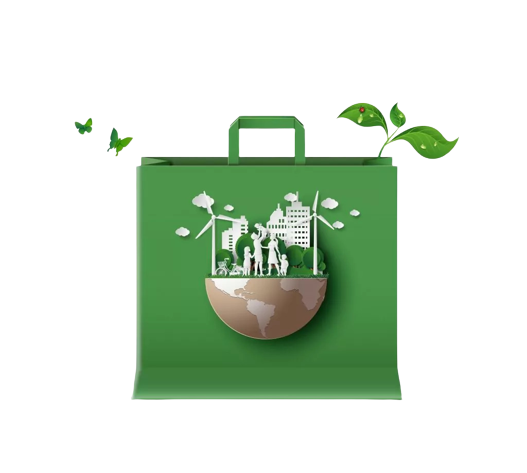Introduction
When we’re considering safeguarding our planet, two words come into consideration: recycled and biodegradable carry bags. They’re both environmentally friendly, yet not substitutable. Biodegradable products break down naturally, while recycled products are transformed into new products from existing products. Let’s consider how each one functions and possibly what one would be preferable for use on a day-in and day-out level.
What Does Biodegradable Mean?
Biodegradable plastics are those plastics that are made from molecules that can readily be altered by nature into carbon dioxide, organic matter, and water. They are commonly natural compounds like sugarcane or naturally found starch that one would find in a piece of corn.
For example, compostable garbage bag packaging will break down after some time while it is in compost. This is a friendlier option for the environment than plastic, which might remain in a landfill for quite some time.
What Does Recycled Mean?
Recyclable materials are materials that result from old materials in order to manufacture new ones. A plastic bottle can be recycled and made into containers, clothing threads, and even furniture.
Recycling doesn’t bring down trash levels to zero — it makes products last longer by extending their lives.
Biodegradable Products vs Recycled Products: Differences
The salient regions of contrast between the two are the following:
| Aspect | Biodegradable Products | Recycled Products |
|---|---|---|
| What They Are | Made from natural materials that can safely break down and return to the earth. | Created by reprocessing used or discarded materials into something new. |
| How They Break Down | Naturally decompose within months with the help of sunlight, moisture, or microbes. | Don’t decompose on their own, but can be collected and turned into new products. |
| Impact on the Planet | Leave behind no harmful residue—completely safe for soil and environment. | Reduce landfill waste and lower the need for fresh raw materials. |
| Common Examples | Compostable grocery bags, compostable courier bags, biodegradable bubble wrap, compostable garbage bags. | Recycled carry bag, recycled garbage bags, recycled garment bag, recycled agarbatti bags |
| Best Use | Great for single-use or disposable items that should return to nature after use. | Ideal for durable items that can be reused or repurposed again and again. |
Biodegradable products reduce waste in the long term, and recycling reduces the need for new products. Both are eco-friendly, yet both solve the garbage problem differently.
Benefits of Biodegradable Products
Starts naturally breaking down without polluting the ground, water, or wildlife.
Lower landfill accumulation.
from natural sources of plants.
Assist us in curbing pollution from single-use plastics.
Biodegradable packaging products are highly effective for packaging one-time containers for biodegradable dog poop bags, edible items that would otherwise create a lot of waste.
Benefits of Recycled Products
Save natural resources like oil, minerals, and timber.
Using less energy during the production of new merchandise.
Do not dump irrelevant materials into the seas and landfills.
We require a circular economy that makes a priority of recycling and the reuse of resources.
Recyclable products are biodegradable bubble wrap, commonly found and affordable, and therefore a more attractive choice for businesses and families.
Challenges of Biodegradable and Recycled Products
While both are environmentally-friendly vehicles, both come with problems included:
The biodegradable products biodegradable compostable cling wrap, need industrial composting for them to decompose. In a landfill, there is no oxygen, and this inhibits decompoy- and resource-intensive, and not all products can be recycled over and over.
Recycling products: Recycling is quite energetic. Some plastics, for example, are less high-quality when recycled that often.
Biodegradable Products & Recycled Products: Which to Choose?
Depends on what you want:
Go for non-biodegradable products if it is your preference that products should decompose totally and not retain any body.
Utilize recycled materials for recycling waste into a new material and a lesser consumption of new raw material.
The end-of-life solution involves compostable packaging for consumable items and recyclable packaging of durable items.
Conclusion
Both the recycled and the biodegradable pieces help the environment and minimize waste. Recyclable pieces keep the material long enough in its own form, and pieces that are biodegradable naturally decompose. Whether we should use either one or the other one or not depends on the feasibility of the case, yet through both we implore adopting a green lifestyle.
Frequently Asked Questions
Q1. Is recycled packaging a superior or inferior packaging to biodegradable packaging?
Ans. It depends. You would be utilizing a biodegradable material when you want it to degrade naturally. This is for recycling material and using less new raw material.
Q2. Do you recycle a non-biodegradable material?
Ans. No, those are products for degradation, not recycling.
Q3. Do recycled products totally decompose?
Ans. No, recycled products don’t vanish. They are transformed into new goods such as containers or yarns.
Q4. Is recycling or biodegradable material less expensive?
Ans. Recycling products is less expensive nowadays, and biodegradable products are also becoming less costly due to new technology.
Q5. Where can recycled and biodegradable products be purchased?
Ans. They can be purchased at grocers, environmentally friendly stores, and online. Environmentally-friendly firms now offer green packaging, bags, and home products.


